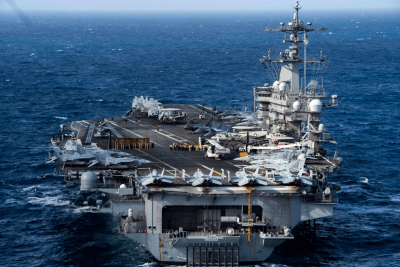For the first time, China has revealed the specifications of its YJ-21 hypersonic anti-ship missile, which was first observed last April during a test launch from a Type 055 cruiser. Alongside air-launched and land-based hypersonic missiles, the YJ-21 signals China’s nascent hypersonic weapons triad for conventional deterrence.
This week, South China Morning Post (SCMP) reported that the People’s Liberation Army – Strategic Support Force (PLA-SSF) published an article in its official Weibo account that states the YJ-21 missile can travel at a speed of Mach 10, or 3,400 meters per second.
It also claims that any known shipboard defense system cannot intercept the missile at that speed and that even without an explosion its tremendous kinetic energy will have devastating effects on its target.
The PLA-SSF article also claims that the YJ-21’s introduction marks a significant evolution in China’s anti-access/area denial (A2/AD) capabilities, highlighting the operational flexibility and survivability advantages of a sea-based launch platform such as the Type 055 cruiser.
The PLA-SSF’s release of information on the YJ-21 may serve as a deliberate warning against the US and its allies after then-US Speaker of the House Nancy Pelosi’s controversial visit to Taiwan last August.
The unveiling of the YJ-21’s export version at last year’s Zhuhai Airshow, designated the YJ-21E, indicates that the domestic version of the YJ-21 is no longer China’s most advanced model of the type and that it may have more capable missiles in its inventory.
The SCMP article notes that since it was the PLA-SSF that released information about the YJ-21, the missile relies on satellite guidance provided by the PLA-SSF to hit its targets. This implies that the YJ-21 is reserved as a strategic weapon against US carriers, the most critical assets of US force projection in the Pacific.

Asia Times has noted that the integration of the YJ-21 on the Type 055 cruiser makes the class one of the most heavily-armed warships in the world, with 128 VLS cells arranged in two silos of 64 cells each, a 130 mm H/PJ-38 main gun, Yu-8 anti-submarine rockets and Yu-7 lightweight torpedoes launched from two triple torpedo tubes.
Brent Eastwood mentions in a December 2022 article from 1945 that with the YJ-21 the Type 055 cruiser will become one of the People’s Liberation Army-Navy’s (PLA-N) most capable assets.
Furthermore, Eastwood notes that the Type 055 cruiser, the Type 052D destroyer and the upcoming next-generation frigate will be integrated into China’s carrier battlegroups, which would operate in the East China Sea, South China Sea and Taiwan Strait.
At the strategic level, China’s emerging hypersonic weapons triad may align with its evolving concept of conventional deterrence, which seeks to deter the US and its allies from intervening in a Taiwan contingency.
Michael Chase and Arthur Chan state in the 2016 book China’s Strategic Deterrent Concepts that China views conventional deterrence as an essential complement to nuclear deterrence.
Chase and Chan note that Chinese military publications state that conventional deterrence is increasingly becoming more powerful due to the “informatization” of conventional strike capabilities.
They also say that conventional weapons are more applicable to a broader range of circumstances, have greater flexibility than nuclear weapons and are not subject to the political constraints of using nuclear arms.
Richard Weitz, in a January 2022 article in China-US Focus, outlines five possible Taiwan scenarios that include China using military force to seize all of Taiwan, a limited operation to blockade Taiwan and capture its frontline islands, deliberate manipulation of risks in a squeeze-and-relax strategy, and avoidance of conflict altogether through transparency and confidence-building measures.
In all but the last scenario, conventional weapons such as China’s hypersonic weapons will play a vital role, from an outright seizure of Taiwan to conveying the threat of force and raising costs to discourage US and allied intervention on behalf of Taiwan.
Indeed, China’s unveiling of its YJ-21 hypersonic anti-ship missile may be essential in its efforts to build a flexible conventional deterrent against US and allied intervention in a Taiwan scenario.
Besides having the ship-based YJ-21 in its Type 055 cruisers, China’s strategic bombers may also carry an air-launched variant. Defense analyst H I Sutton has previously reported on an air-launched variant of the YJ-21 carried by the People’s Liberation Army-Air Force’s (PLA-AF) H-6 strategic bomber.
As noted by Asia Times, air-launched hypersonic anti-ship missiles improve China’s standoff strike capabilities against US bases and warships in the Pacific, with an air launch potentially increasing the YJ-21’s already formidable performance, with the H-6 bomber adding 3,500 or more kilometers to the missile’s range.
In such a configuration, the YJ-21 may be employed against US and allied forces in faraway locations such as Okinawa or Guam.
China’s sea and air-launched hypersonic anti-ship missiles can also complement its land-based arsenal of such weapons. As noted by Missile Threat, China’s road-mobile DF-17 was first spotted in 2014 and may have entered PLA service in 2019.
The report notes that the DF-17 is estimated to have a range between 1,800 to 2,500 kilometers, is capable of extreme maneuvers and can reach up to Mach 5 in its glide phase. Notably, Chinese state media outlet Global Times has previously reported that the DF-17 was among the missiles China fired in a show of force to protest Pelosi’s visit to Taiwan last year.

Those launches may have intended to show that China can effectively “box in” Taiwan with long-range precision fires alongside a persistent blockade of warships and submarines.
The emergence of hypersonic anti-ship missiles puts the importance of carriers as the mainstays of modern naval warfare into question.
As noted by Jon Harper in a 2019 article in National Defense Magazine, hypersonic missiles such as the YJ-21 – unlike conventional ballistic missiles – can maneuver during their terminal phase to evade shipboard missile defenses.
Harper also notes that while existing anti-ship missiles can be highly maneuverable, they typically fly at subsonic speeds, unlike hypersonic anti-ship missiles that give little to no window for their targets to react.

